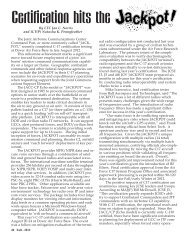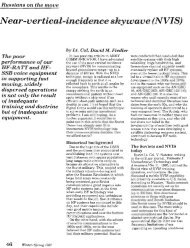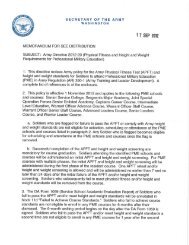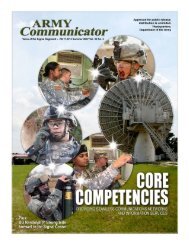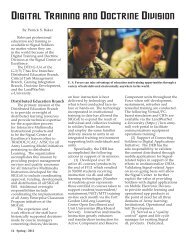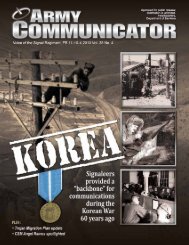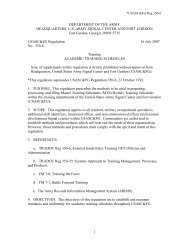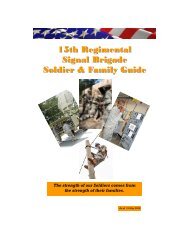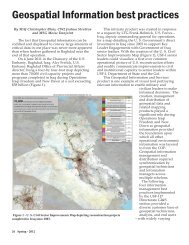AC Summer 08 WIN-T Online - United States Army Signal Center of ...
AC Summer 08 WIN-T Online - United States Army Signal Center of ...
AC Summer 08 WIN-T Online - United States Army Signal Center of ...
Create successful ePaper yourself
Turn your PDF publications into a flip-book with our unique Google optimized e-Paper software.
<strong>WIN</strong>–T Personnel<br />
Requirements<br />
By MAJ Alprentice “Al” Smith and<br />
John Plotts<br />
In the current operational<br />
environment, the <strong>Signal</strong> Regiment<br />
enables the warfighting function<br />
command and control by installing,<br />
operating, and maintaining <strong>Army</strong><br />
communications networks and<br />
information services. Command and<br />
control <strong>of</strong> <strong>Army</strong> and Joint forces will<br />
require a seamless communications<br />
network that is robust and capable<br />
<strong>of</strong> supporting full spectrum operations.<br />
The military occupational<br />
specialty structure and the training<br />
provided to our Soldiers is the<br />
critical factor in providing this<br />
indispensible capability.<br />
Many <strong>of</strong> the readers <strong>of</strong> this<br />
article will remember Mobile<br />
Subscriber Equipment. It was a<br />
communications system that provided<br />
many years <strong>of</strong> good service,<br />
but Operation Iraqi Freedom proved<br />
that our combat forces needed much<br />
more capability not the least <strong>of</strong><br />
which is command and control onthe-move<br />
or C2OTM. In an unprecedented<br />
acquisition, the <strong>Army</strong><br />
purchased what we then called JNN<br />
– Joint Network Node – which<br />
provided a satellite based at-thequick-halt<br />
capability and moved the<br />
<strong>Army</strong> closer to C2OTM.<br />
In an amazing display <strong>of</strong><br />
agility, the <strong>Army</strong> was able to design,<br />
purchase, and field our first JNN in<br />
about six months. In fact, we fielded<br />
the equipment so fast that we<br />
received Headquarters Department<br />
<strong>of</strong> the <strong>Army</strong> approval for a new<br />
MOS (25N) to install, operate, and<br />
maintain this equipment after it was<br />
fielded.<br />
New Equipment Training<br />
picked up the slack initially and now<br />
we have a steady stream <strong>of</strong> 25N<br />
Soldiers generated by our Advanced<br />
Individual Training courses at Fort<br />
Gordon. As many <strong>of</strong> you know, this<br />
Command and control<br />
<strong>of</strong> <strong>Army</strong> and Joint<br />
forces will require a<br />
seamless communications<br />
network that is<br />
robust and capable <strong>of</strong><br />
supporting full spectrum<br />
operations. The<br />
military occupational<br />
specialty structure and<br />
the training provided to<br />
our Soldiers is the critical<br />
factor in providing<br />
this indispensible capability.<br />
transition created an imbalance in<br />
the inventory <strong>of</strong> Soldiers in certain<br />
MOSs that is only now starting to<br />
rebalance.<br />
Today, JNN is part <strong>of</strong> the <strong>WIN</strong>-<br />
T program called <strong>WIN</strong>-T Increment<br />
1. The <strong>WIN</strong>-T program goes well<br />
beyond JNN and brings many more<br />
capabilities to the force. Although<br />
JNN was just the first glimpse <strong>of</strong><br />
what <strong>WIN</strong>-T would look like, we<br />
designed the 25N not only for JNN,<br />
but so that this MOS could evolve<br />
along with the evolution <strong>of</strong> the <strong>WIN</strong>-<br />
T program. <strong>WIN</strong>-T is a high-speed<br />
and high capacity backbone communications<br />
network. It will be focused<br />
on moving information in a manner<br />
that supports commanders, staffs,<br />
functional units, and capabilitiesbased<br />
formations – all mobile, agile,<br />
lethal, sustainable, and deployable.<br />
C2OTM will be fully realized in later<br />
increments <strong>of</strong> <strong>WIN</strong>-T. If this sounds<br />
like some tremendous capability, it<br />
is, but <strong>WIN</strong>-T will not meet the<br />
needs <strong>of</strong> the commander without<br />
well-trained Soldiers and leaders <strong>of</strong><br />
the <strong>Signal</strong> Regiment.<br />
As the <strong>Signal</strong> Regiment continues<br />
to develop the hardware and<br />
equipment required to employ the<br />
various increments <strong>of</strong> the <strong>WIN</strong>-T<br />
program, the Regiment, through the<br />
Office Chief <strong>of</strong> <strong>Signal</strong>, is also determining<br />
the personnel requirements.<br />
These requirements are being<br />
analyzed in terms <strong>of</strong> the five Regimental<br />
core competencies that were<br />
published in an earlier article,<br />
<strong>Summer</strong> 2007 edition <strong>of</strong> the <strong>Army</strong><br />
Communicator, and our initial focus is<br />
on the three competencies that<br />
comprise the critical components <strong>of</strong><br />
network operations. <strong>Signal</strong> Soldiers<br />
must be able to execute Enterprise<br />
Systems Management, or said<br />
another way, to install, operate, and<br />
maintain <strong>WIN</strong>-T systems.<br />
Our people also need to be<br />
competent in Information Dissemination<br />
Management and Content<br />
Staging. This competency goes to the<br />
heart <strong>of</strong> how we technically enable<br />
having the right information available<br />
at the right time and at the right<br />
place. And finally, our Soldiers must<br />
be able to exercise the core competency<br />
<strong>of</strong> Information Assurance and<br />
Computer Network Defense or in<br />
layman’s terms, protect our networks.<br />
As you can imagine, there is a<br />
definitive process we must use to<br />
identify personnel requirements for<br />
emerging technologies. OCOS is<br />
working closely with the materiel<br />
developers, trainers, and Program<br />
Managers in the review <strong>of</strong> developmental<br />
task analysis reports and<br />
draft training materials for <strong>WIN</strong>-T<br />
configuration items to determine<br />
skill sets and knowledge requirements.<br />
This analysis is then crosswalked<br />
to existing <strong>of</strong>ficer areas <strong>of</strong><br />
concentrations and warrant and<br />
enlisted MOSs to develop the<br />
personnel structure. Since many <strong>of</strong><br />
<strong>Army</strong> Communicator 67



